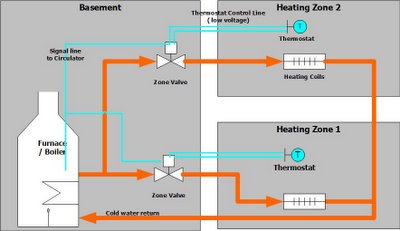 We woke up at 5AM yesterday in a sweat.
We woke up at 5AM yesterday in a sweat.
This is somewhat unusual -- this time of the year, its freezing outside and 5AM on a Sunday is the time to stay in the warm comfort of the bed, preferably deep asleep. Not so on this eventful Sunday, as I mentioned. I got out to check the thermostat - and it was showing a balmy 87 degrees ! ( the cost of the gas bill made me sweat a little more ;-)
Diagnosis:
A 30 year old heating system -gas fired boiler with forced hot water, and 2 zones.- My first thought was : Bad thermostat. So I turned the thermostat all the way down. No difference, the heat continued to rise.
- Then I went downstairs to check the temperature there -- the lower level ( a separate heating zone) was fine. Hmm .. Back upstairs, I turned the thermostat off. Still no difference.
- I pulled the thermostat out from the wall and disconnected it completely. ( I did tape the wire to the wall and insulate the ends with some electrical tape :) Still no difference to the heater, which kept heating like there was no tomorrow. A kitchen thermometer showed 90 degrees. Now I was getting worried, so I went down to the basement and shut off the boiler using the master switch. Ok .. Now to go back to the diagnosis with a cool head, so to speak.

The hot water pipe coming out of the boiler forks to feed my 2 heating zones. There are solenoid valves at the fork that control the flow of the heated water into the coils. The 2 wires from each of the thermostats from the heating zones connect into these 'zone valves'.
A third wire from the zone valve connects to the circulator in the boiler to tell it turn on when the valve is open and heat is required.
So my process of elimination looked like this :
- If the furnace or the circulator had a problem, both zones would be affected. Since my overheating problem was limited to the top zone, clearly the issue was in the circuitry for that zone.
- I had already disconnected the thermostat - so the only other possibility was the zone valve. Mine is a brand called Taco.
Repair:
Cool, huh ? Now to see if we can actually do something about it.I drove over to the local borg ( big orange retail giant :) The folks there are usually pretty helpful -- so I took along a picture of the suspect valve on my cellphone (that's the first picture on the post). Maybe it was the Sunday staff, or just the luck of the draw, but the gentleman in this case gave me the standard speech on how not to touch your heating system unless you are licensed.
Hmm .. back to the web! I found a couple of useful posts :
- http://masterplumber.net/Zone_Valves.htm
- http://forum.doityourself.com/archive/index.php/t-204409.html
A little more looking and I see that they stock the solenoid portion of the valve (the powerhead) separately. The valve itself seems very solidly built, all brass -- so chances are that my solenoid has failed. It looks like a very easy fix -- 3 wire connections and the solenoid itself has a twist-fit connection to the base.
Back home, with the furnace still switched off I replaced the powerhead. Basically :
- Label the 3 wires , then disconnect and immediately insulate ends with electrical tape.
- Twist the old powerhead about 30 degrees clockwise to remove. It comes off quite easily. Looking inside -- it was actually quite corroded.
- Clean the seat thoroughly with some penetrant oil.
- Twist fit the new powerhead on. Connect the 3 wires, taking care not to short anything.
- Turn on the system and test operation by turning the thermostat up and down !
What it might have cost : Around $300 - $400, based on some estimates I found, possibly more since it was a weekend.
Thoughts / Comments / Any other heating system tips you'd like to share ? Let me know !
Disclaimer :
I shouldn't have to say this, but I am not a mechanic or licensed or certified! ( See the definition of dabbler! ) The story above is for your reading pleasure, so please don't attempt to duplicate unless you know what you are doing.